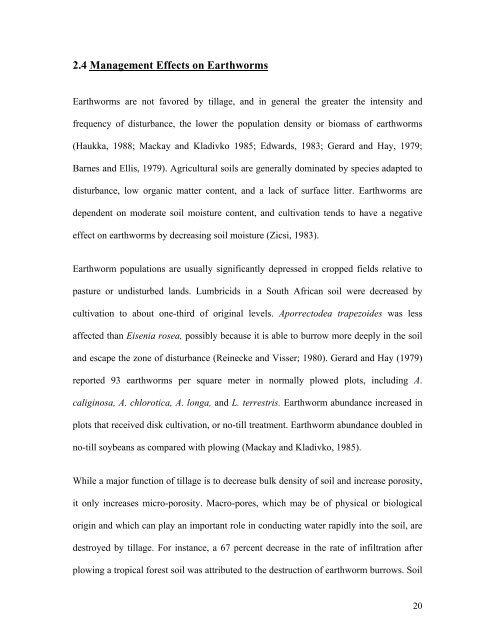Mekelle University The School of Graduate Studies Faculty of ...
Mekelle University The School of Graduate Studies Faculty of ...
Mekelle University The School of Graduate Studies Faculty of ...
- No tags were found...
Create successful ePaper yourself
Turn your PDF publications into a flip-book with our unique Google optimized e-Paper software.
2.4 Management Effects on EarthwormsEarthworms are not favored by tillage, and in general the greater the intensity andfrequency <strong>of</strong> disturbance, the lower the population density or biomass <strong>of</strong> earthworms(Haukka, 1988; Mackay and Kladivko 1985; Edwards, 1983; Gerard and Hay, 1979;Barnes and Ellis, 1979). Agricultural soils are generally dominated by species adapted todisturbance, low organic matter content, and a lack <strong>of</strong> surface litter. Earthworms aredependent on moderate soil moisture content, and cultivation tends to have a negativeeffect on earthworms by decreasing soil moisture (Zicsi, 1983).Earthworm populations are usually significantly depressed in cropped fields relative topasture or undisturbed lands. Lumbricids in a South African soil were decreased bycultivation to about one-third <strong>of</strong> original levels. Aporrectodea trapezoides was lessaffected than Eisenia rosea, possibly because it is able to burrow more deeply in the soiland escape the zone <strong>of</strong> disturbance (Reinecke and Visser; 1980). Gerard and Hay (1979)reported 93 earthworms per square meter in normally plowed plots, including A.caliginosa, A. chlorotica, A. longa, and L. terrestris. Earthworm abundance increased inplots that received disk cultivation, or no-till treatment. Earthworm abundance doubled inno-till soybeans as compared with plowing (Mackay and Kladivko, 1985).While a major function <strong>of</strong> tillage is to decrease bulk density <strong>of</strong> soil and increase porosity,it only increases micro-porosity. Macro-pores, which may be <strong>of</strong> physical or biologicalorigin and which can play an important role in conducting water rapidly into the soil, aredestroyed by tillage. For instance, a 67 percent decrease in the rate <strong>of</strong> infiltration afterplowing a tropical forest soil was attributed to the destruction <strong>of</strong> earthworm burrows. Soil20
















